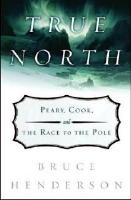|
‘True
North’ study favorable to
Cook claims
They
had started out as friends
and shipmates, with Cook, a
doctor, accompanying Peary,
a civil engineer, on an
expedition to northern
Greenland in 1891.
Peary’s leg was shattered
in an accident, and without
Cook’s care he might
never have walked again.
But by the fall of 1909,
all the goodwill was gone.
Peary said he had reached
the Pole in April 1909;
Cook scooped him,
presenting evidence that he
had gotten there in 1908.
~
True North
Bruce
Henderson, a non-fiction
writer whose books have
appeared on the New York
Times best-seller lists,
and who was previously
acclaimed for his work on
the ill-fated Polaris
expedition, has authored a
new work on the Cook-Peary
expedition. True North:
Peary, Cook and the Race to
the Pole (W.W. Norton) will
be published in February
2005.
Henderson’s
narrative, which is
reviewed in this issue of
the journal on page 46, is
conclusive toward a
favorable assessment of the
North Pole priority of
Frederick A. Cook with six
specific arguments:
 |
|
Henderson
writes that while
Cook acknowledged
being “uncertain
as to having reached
the exact
mathematical
Pole,” he believed
he had gotten as
close as any man of
his day could
intelligently claim.
“Given the
ever-drifting ice
pack, placing the
toe of one’s boot
on the exact spot
was rather like
hitting a constantly
moving target with a
dart. Just how close
did one have to come
in order to claim
the Pole? Within a
hundred feet? A
mile? More than
simply reaching that
pinpoint spot on the
ice at 90-degree
North for a moment
in time before it
drifted away, Cook
yearned to be judged
on the accuracy of
his Polar
descriptions, while
being recognized for
having been the
first to offer them
in detail to the
world – days, even
weeks, ahead of
Peary, who had the
opportunity to read
Cook’s narrative
before releasing his
own.” |
Those
points supporting Cook’s
claim of reaching the Pole
in 1908:
Experience
and readiness for the
journey: Cook had
adopted many Eskimo methods
of travel, and designed his
own sledges and other
equipment. He believed in
the importance of a smaller
party that traveled as
light as possible, and
lived off the land whenever
possible. Experienced in
Arctic travel, Cook was
forty-three, in excellent
shape, and had in his
company for the trek to the
Pole two of the most
capable native hunters and
sledge drivers in the
region.
Proven
ice traveler: For Cook
to have traveled to and
from the Pole, he would
have gone approximately
2,680 miles. The
uncontested part of the
journey – that which
Peary contended Cook’s
natives confirmed –
amounted to 1,640 miles. As
Cook’s capacity for
making a long, sustained
journey in the Arctic
cannot be in doubt, it
could be concluded that he
had the ability to travel
the additional 1,040 miles
to reach the Pole and
return.
Original
descriptions: With the
passage of time, Cook’s
original Polar descriptions
have held up. At the time
of his journey no one had
seen the region between 87
degrees and 90 degrees
North, and there was much
speculation as to what
would be found at the Pole,
ranging from an open polar
sea to land, even a new
race of people. Upon his
return, Cook described what
he had seen; no land, a
continuation of the Polar
ice pack, a frozen ocean in
a state of continuous
motion and upheaval. Future
accounts, including
Peary’s narrative, agreed
with Cook’s original
descriptions.
Unknown westerly drift:
Caught in heavy fog on his
return from the Pole, Cook
navigated by dead
reckoning, allowing for
what he anticipated would
be a slight castward drift
of the ice (previously
reported in pack-ice north
of Ellesmere). It was not
then known that the drift
in the area he was passing
through was westerly. As a
result, Cook and his
companions were carried one
hundred miles west of their
plannedl andfall near their
caches, and the resultant
delay meant they were
trapped by winter. This
westward drift first
reported by Cook –
between thePole and 80
degrees North roughly along
100 degrees longitude - was
confirmed by later
explorers.
|
'With
the passage of time,
Cook’s original
Polar descriptions
have held up' |
Ice
islands: Cook reported
seeing at 88 degrees North
an unusual ice structure he
described as flat-topped,
and higher and thicker than
sea ice, with an upper
surface marked by
undulations or waves. What
Cook probably observed was
an ice island, an Arctic
feature never before
reported. It was later
discovered that ice islands
are tabular masses of ice
originating from the ice
shelves that rim parts of
the north coast of
Ellesmere; when they break
off, they drift into the
Arctic Ocean between Alaska
and the North Pole in a
slow clockwise motion.
Cook’s description of the
“flat-topped” mass was
largely forgotten until
forty years later when
several large ice islands
of the same description
were discovered during an
aerial reconnaissance.
Credible
and consistent narrative: Cook’s
descriptions of his Polar
trip have never been
refuted, other than his
reported sighting of
Bradley Land. Some modern
Arctic experts believed
that in reporting Bradley
Land and Crocker Land
(about 150 miles apart),
Cook and Peary,
respectively, may have seen
drifting ice islands.
“Neither investigated
their find at close range,
“ reported Rear Admiral
C. W. Thomas, a veteran of
scientific work in the
Arctic, some fifty years
after the reported
sightings in 1908 and 1909.
Thomas thought it possible
Cook and Peary had spotted
the same ice island –
“it is significant that
no one has since seen
either island.” Other
than that exception, no
other original Arctic
description provided by
Cook has ever been
disproved.
For
more Polar Priorities
and Membership News
stories, check our online
archive
Copyright
2005 - The Frederick A.
Cook Society
|